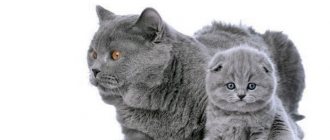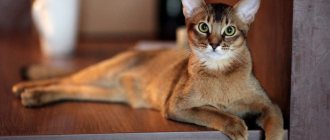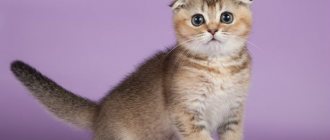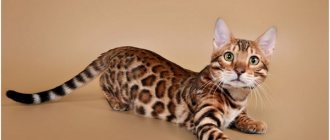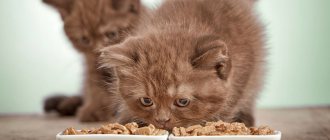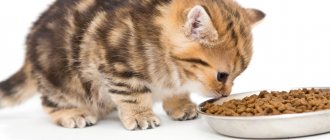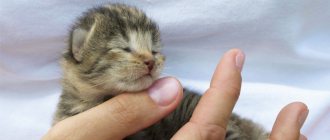Bengal cat - features of the breed
The potential owner should study the breed characteristics of the future pet. First of all, you should know about all the nuances related to health and care. In general, Bengal cats are characterized as potentially healthy animals. The level of activity of adult animals is average, but up to the age of one year, kittens are very restless.
Genetic diseases that are not affected by diet and care are:
- Hypertrophic cardiomyopathy is a congenital cardiac anomaly.
- Leukemia is a severe, chronic and often fatal blood disease.
Bengals are prone to viral and colds, especially if there are relatives in the family tree (this happens often). Representatives often experience an unexplained decrease in immune defense, which can be either temporary or chronic.
Veterinarians believe that the quality of care and diet influence sudden changes in the functioning of the immune system.
It is known that Bengal cats quickly adapt to new living conditions. If an adult cat is not provoked to activity, it will sleep most of the day. Calorie feeding without exercise is a direct path to obesity, heart disease and diseases of the musculoskeletal system.
The last thing that needs to be taken into account is the tendency of representatives of the breed to sensitivity and various diseases of the gastrointestinal tract. The development of such pathologies is influenced by the quality and balance of the diet.
Character
Keeping Bengals in enclosures leads to their rapid wilding. But in a pack they feel great. If it is possible to take two kittens, this will be a good option for them. The Bengal cat, contrary to rumors, is not aggressive or even bloodthirsty. He gets along well with children and poses no danger to them. Only rodents and birds should be afraid of it.
When raising small Bengal kittens, it is necessary to accustom them to handling from the first day. Then they will become affectionate friends, but otherwise wild animals.
These cats are quite smart and quick-witted. They easily learn to open doors and even flush the toilet. Like their wild cousins, Bengals have a special love for water. However, this does not mean that they swim in the bathtub, or even dive. They like running water. In this case, you can watch the splashes and catch them with your paw.
Cats of this breed become very attached to their owner and become dependent on humans. They love to engage in conversations, as they have a fairly wide range of different sounds in their arsenal.
Another interesting character trait of Bengals is their love of water. Animals of this breed, contrary to prejudices that cats are afraid of moisture, enjoy swimming and taking baths.
If a Bengal cat has to get into a fight, its behavior is different from other breeds. Bengals do not rush at the enemy head-on, but wait for the moment when he turns his back to him, and pounce from behind - an echo of wild origin.
Representatives of this breed have a lot of advantages, but it is worth understanding that it is impossible to accurately state and attribute any character traits to all Bengal cats. Each animal is unique, but some advantages specific to this particular breed can still be highlighted.
- Lack of aggressiveness and contact. As a rule, Bengals get along well with children and get along well with other pets.
- Adequacy and intelligence. Bengal cats rarely get into fights with stronger opponents. They prefer to avoid such clashes.
- Love of bathing. Owners will have no problems if the need arises to bathe their pet.
- Courage. Bengal cats actively guard and defend their territory from strangers. These animals are difficult to scare.
- Ability to learn. Animals of this breed are very capable, they can even be taught some tricks (for example, flushing the toilet or turning off the light in the room).
- Good qualities of mousecatchers. Hunting instincts play a good role when fighting rodents.
Speaking about shortcomings, we can say that they arise from character strengths.
- The animal's activity allows it to be playful, but at the same time, left alone for a long time, the Bengal can make a big mess.
- Attachment to the owner makes the Bengal cat a loyal friend, but the animal is not able to remain alone for a long time and does not tolerate when the owner does not have time for him.
- The independence of cats makes them not entirely tame. Bengals love to be on an equal footing with humans, but they don't particularly like being cuddled or picked up frequently.
Choosing a place and utensils for feeding
After moving to a new home, the kitten is stressed, although it may not show it outwardly. Separation from the mother and change of environment can turn stress into physical illness. To simplify the adaptation process, the future owner needs to prepare the conditions for the kitten in advance.
The choice of place and utensils for feeding plays an important role in the adaptation of the pet. While eating, the kitten should feel comfortable and safe. If you have other pets in the house, try to feed the newbie separately so he doesn't have to compete for food.
The eating area should be comfortable for the pet and clean. To make cleaning easier, you can place a small rubber mat under the bowls. The rubber coating is easy to clean; in addition, the mat prevents the kitten from slipping if he is in a hurry to get to the bowl.
Give preference to ceramic or stainless steel bowls. The downside of ceramic bowls is that they break when dropped from a height. The advantages include ease of care and significant weight - ceramic bowls do not slip. Stainless steel bowls are unbreakable and can be treated with boiling water. However, steel bowls are lightweight, so they need to be placed on a stand.
Transfer to new food
Veterinarians advise choosing a feeding method once and for all, but sometimes it becomes necessary to change dry or wet ready-made food to meat and cereals. In this situation you need to be very careful. The sensitive digestive system of Bengals does not like sudden changes in food, so you need to transfer your pet to a new diet gradually and with the utmost care.
Before feeding your Bengal cat a new food, it is better to do a little testing: add some of the selected food to the cat's regular menu and check if she agrees to eat this product and if she feels good after such a meal.
What else to see:
What to feed a Bengal kitten - choosing the type of diet
You can feed your Bengal kitten using different types of feeding:
- Natural.
- Industrial.
- Mixed.
When making a choice, you need to rely on the needs of the pet and your capabilities. Frequent changes in diet have a negative impact on your pet's health. According to the recommendation of veterinarians, it is better not to change the type of diet until the age of one year. However, if the kitten has moved to a new home and is accustomed to a type of food that does not suit you, the diet can be changed after an adaptation period.
Natural diet
A natural diet is considered more natural for pets. Absolutely all manufacturers of dry food strive (as they are not shy about saying in advertising) to produce products that are as similar as possible to natural food.
A natural diet for a Bengal kitten includes:
- Feeding raw and cooked foods in pure and mixed form.
- Feeding exclusively raw foods is a raw food diet.
- Feeding with homemade semi-finished products.
Benefits of a natural diet:
- Food is better absorbed even by animals with sensitive digestion.
- You can control the freshness and quality of the products.
- If you experience food allergies or don’t think about mysterious ailments of the gastrointestinal tract, you can easily choose a gentle diet.
- You can adjust the calorie intake depending on the season of the year and the activity of your pet.
- A natural diet is 2–3 times cheaper than ready-made food of similar quality.
- A natural diet involves regular vitamin courses.
Disadvantages of a natural diet:
- Natural food spoils quickly, so you need to cook it regularly for your pet, which costs time.
- Natural food should not be left in an automatic feeder.
- A natural diet involves regular vitamin courses.
A Bengal kitten can be switched to a natural diet from the age of one month. Until 4–4.5 months, babies eat soft and liquid food.
Until about 10 months of age, kittens willingly consume almost all products offered to them. From the age of one, a cat develops taste preferences that are very difficult to change.
Ready-made feed
Dry canned commercial cat foods are becoming increasingly popular. Most likely, the reason is that the pace of life of owners is constantly accelerating and there is simply no time left to prepare natural food for their pet. The ready-made food market is replete with assortment, but not all products are suitable for a Bengal kitten, especially if the animal has a tendency towards chronic pathologies.
Ready-made feeds are divided into types:
- Dry – granules.
- Semi-moist - pieces with gravy or jelly.
- Wet - pate or paste.
Food manufacturers and veterinarians do not recommend feeding domestic cats only one type of food.
- For adult animals, a diet of 75% dry and 25% wet food is recommended.
- For kittens, the mass fraction of wet food should be at least 50–60%.
The key factor when choosing food for your pet is its quality or class:
- Economy
- Premium
- Super premium.
- Holistic.
Super-premium and holistic class foods are suitable for feeding Bengal cats.
If your pet is young, healthy and active, food from the everyday line will be suitable for him. If the animal has chronic pathologies or tendencies to them, it is necessary to choose products from lines for animals with special needs:
- Supportive.
- Preventive.
- Medicinal.
- For exhausted kittens and adult animals.
- Hygienic (usually treats).
Advantages of ready-made feed:
- Significant time savings.
- Dry food can be left in an automatic feeder so that your pet can eat while you are at work.
- Holistic and super-premium food contains a basic complex of vitamins.
Disadvantages of ready-made feeds:
- Feeding high-quality finished products costs several times more than a natural diet.
- There is always a risk of buying counterfeit food, which threatens the health of your pet.
- If an allergy or sensitivity of the digestive tract is detected, the cat must be switched to preventive food, which is more expensive than the daily line.
If a kitten is deprived of maternal care, it can be fed with an industrial cat's milk substitute from the first day of life. Supplementary feeding from ready-made feed is introduced in the first month of life.
Until the complete change of teeth, the kitten should receive soft food: canned food and soaked dry food. After changing baby teeth, dry food can be introduced into the Bengal kitten's diet.
Mixed diet
Many owners consider a mixed diet a convenient and affordable option for feeding their pet. A mixed menu involves feeding industrial and natural products. Feed manufacturers and veterinarians recommend refraining from mixed feeding, since such a diet is fraught with the development of dysbiosis.
The main problem is that the cat's digestive system adapts to digest food of a certain structure. Dry food and natural products have different structures and take different amounts of time to digest. With mixed feeding, some of the food is not digested, but rots, which leads to the death of colonies of friendly bacteria.
Mixed feeding is considered acceptable if high-quality canned food is added to natural food. Mixed feeding can be a temporary measure, for example, when transferring a cat from a natural to an industrial diet.
Conditions of detention
Bengals are highly trainable. They are incredibly smart and learn very quickly. At least Bengals can carry out basic commands more typical for dogs. By the way, Bengals are also great at walking on a leash.
Bengals are very energetic and love to play. Therefore, it is important to arrange their personal space in such a way that they can occupy themselves. Climbing posts and hanging ladders, platforms at different levels - the more opportunities the cat has for jumping, climbing and other activities, the better.
Cats of this breed have a very sensitive sense of smell, so it is very important that both the house and the objects surrounding the cat do not have strong irritating odors. This can harm the animal, especially young ones.
Sample menu by age
By drawing up an approximate menu by age, you can sensibly assess your physical and financial capabilities. It is important to remember that it is advisable not to change a kitten’s diet until it is one year old. Valid reasons for a sudden change in diet are considered to be: feeding with economy class feed and an unbalanced natural diet.
Up to 1 month
Until the age of one month, kittens feed exclusively on their mother's milk. In the first few days of life, kittens feed on colostrum, which contains antibodies, a large amount of proteins and friendly bacteria. If a kitten, for some reason, is deprived of maternal care, it is fed artificially.
Natural menu:
- Goat milk diluted with boiled water.
- Scott's kitten mix.
- Tiling mix for kittens.
Industrial menu:
- Cat milk replacer.
- From 1.5–2 weeks – infant formula “from 0” (without additives and sugar).
The daily food intake for a Bengal kitten under one month of age ranges from 30 to 50 ml.
Number of feedings:
- From birth to 2 weeks - every 2 hours, a total of 10 times a day.
- From 2 to 4 weeks - every 2-3 hours, a total of 8 times a day.
When artificially feeding a kitten under one month of age, many veterinarians recommend focusing on the baby’s behavior. If the kitten squeaks, it means he is hungry.
With this approach, you can overfeed the baby, since squeaking can indicate both hunger and stress. The only way to monitor height and weight gain is to weigh the kitten regularly.
1 month
At 1 month, kittens begin to open their eyes and leave the nest. Babies' hearing and sense of smell become more acute, they begin to become interested in the outside world and the smell of the food that the mother cat eats. To encourage the kittens' interest, the breeder introduces supplementary food into their diet.
Natural menu:
- Mother's milk.
- Whole goat or cow's milk.
- Low-fat beef broth.
- Boiled minced meat mixed with broth and homemade meat pate.
Industrial menu:
- Cat milk replacer or infant formula.
- In case of growth retardation - pate for emaciated kittens.
The daily food intake ranges from 40–80 grams.
Number of feedings: 6–7 times a day, excluding mother’s milk.
2 months
At 2 months, kittens have a full set of baby teeth and learn to chew. However, babies try to stay close to their mother and milk makes up the bulk of their diet.
Natural menu:
- Mother's milk or natural substitute.
- Whole cow's or goat's milk.
- Calcined cottage cheese.
- Dairy products.
- Bouillon.
- Boiled minced meat (carefully chopped).
- Chopped, raw, boiled or pre-frozen meat (beef).
Industrial menu:
- Cat milk replacer or infant formula.
- Canned food for kittens.
The daily food intake for a Bengal kitten at the age of 2 months directly depends on body weight and ranges from 40–90 grams.
The number of feedings varies from 5 to 6 times a day.
3 months
At 3 months, a Bengal kitten will face a number of stresses: primary vaccination, anthelmintic measures and moving to a new home. Against the background of changes, the kitten's appetite may worsen and there may be a slight stagnation in weight gain. This reaction of the body is considered natural.
Natural menu:
- Mother's milk or its substitute.
- Whole milk, fermented milk products, calcined cottage cheese.
- Boiled minced meat, raw, chopped meat.
- The broth is low-fat, pure or with egg.
- Raw quail eggs or chicken egg yolk. Can be mixed with cottage cheese.
- Raw grated carrots, a little green apple.
Industrial menu:
- Cat milk replacer or infant formula.
- Canned food for kittens.
- Semi-moist food for kittens.
The serving size for a Bengal kitten at the age of 3 months remains the same, but due to the increased nutritional value, the baby remains full longer. Number of feedings at the age of 3 months: 5–6 times a day.
4–6 months
At the age of 4–6 months, the kitten’s body prepares for a change of teeth. In addition, the Bengal kitten becomes more active and curious, which means an increase in calorie needs.
Natural menu:
- Whole milk, fermented milk products, cottage cheese - in large quantities.
- Boiled and raw meat without fat and bones - beef, veal, rabbit.
- Ocean fish, low-fat - chopped, deboned, boiled or after deep freezing.
- Beef or poultry by-products, boiled, chopped.
- Chicken and quail eggs – raw, boiled, scrambled eggs (without oil). Can be mixed with vegetables or dairy products.
- Vegetables – raw, grated.
Industrial menu:
- Pates.
- Semi-moist food.
- Soaked dry food.
The daily food intake for a Bengal kitten aged 4–6 months ranges from 80–120 grams.
Number of feedings at the age of 4–6 months: 4–5 full meals and 2 light snacks.
From 6 months to 1 year
At the age of 6 months to 1 year, the kitten completes the replacement of milk teeth and the final taste preferences are formed. During this period, it is extremely important to tame your pet to healthy foods if you prefer a natural diet.
Natural menu:
- Meat – beef, poultry, rabbit.
- Meat by-products – beef, poultry.
- Homemade milk.
- Fermented milk products - any, preferably homemade.
- Fish and seafood.
- Fish and meat broths.
- Chicken and quail eggs.
- Vegetables are raw.
- Fruits are not sweet, little by little (as a source of vitamins).
- Greenery, grass.
- Cereals - only with increased activity, stunted growth and obvious lack of saturation with a diet without grains.
Industrial menu:
- Until the complete change of teeth (7–8 months) - wet and semi-moist food for kittens of active breeds, soaked dry food.
- After a complete change of teeth - 75% dry and 25% wet or semi-moist food.
The serving size for a Bengal kitten is determined according to needs, depending on the degree of activity. The final daily food intake is determined individually and ranges from 140 to 200 grams.
The number of feedings is gradually reduced to 2–3 times.
Vitamins and supplements
When feeding with high-quality, industrial feed, vitamins and additives are not introduced into the diet. Additional sources of nutrients are necessary if you prefer natural feeding. Even the highest quality and freshest products cannot compensate for the needs of active cats.
Natural vitamin supplements:
- Meat and bone meal.
- Fish, chicken, beef liver.
- Greens, vegetables, fruits.
- Sunflower oil, olive oil.
- Brewer's yeast.
Pharmacy vitamin supplements:
- Fish fat.
- Feed tricalcium phosphate.
- Omega-3, Omega-6.
- B vitamins.
In addition to vitamins and minerals, cats need taurine. Unlike dogs, which synthesize taurine naturally, cats can only obtain this amino acid from food.
Sources of taurine:
- Turkey.
- Rabbit.
- Chicken heart, liver.
- Beef heart.
- Pork, ham, trimmed of fat, after deep freezing.
- Pork liver, heat-treated.
- Ocean fish, shellfish.
- Raw red fish.
- Homemade live yogurt.
- Whole milk.
To make life easier, the owner can conduct vitamin courses using special, industrial supplements. Vitamin complexes are sold in pet stores and veterinary pharmacies, usually available in the form of tablets or powders.
Prohibited Products
It is important to exclude prohibited foods from your Bengal kitten’s diet:
- Bones, pure fat, skin, especially poultry.
- Palm oil.
- Grapes, raisins.
- Juicy and sweet fruits.
- Soy.
- Mushrooms.
- Corn and semolina.
- Raw freshwater fish.
- Dry, salted fish.
- Smoked products, including sausages, balyki, fish.
- Products containing sugar or its substitutes, xylitol (chewing gum, some sweets), flour or yeast, caffeine, cocoa, any stimulants (sweets, tea, coffee, chocolate), marinades, salt, spices.
- Dog food.
- Expired products.
- Leftovers from the table.
Controversial foods in the diet of a Bengal kitten are:
- Fresh pork is a source of helminths and false rabies.
- Raw ocean fish are a source of helminths.
- Whole milk – risk of individual intolerance.
- Chicken eggs are an allergen.
- Factory-bred chicken – risk of allergies and individual intolerances.
- Raw and boiled chicken liver in large quantities.
- Cereals.
Most veterinary nutritionists do not recommend including grains or additional sources of carbohydrates in a cat's diet.
The reason is that the cat’s body synthesizes enough carbohydrates to nourish the nervous system, and additional intake can lead to excess weight gain. However, if your pet is active and does not gain weight well, you can add buckwheat or rice to its diet.
